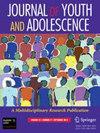Does Expressive Suppression Precede Depressive Symptoms in Adolescence?
IF 3.6
1区 心理学
Q1 PSYCHOLOGY, DEVELOPMENTAL
引用次数: 0
Abstract
The association between expressive suppression and depressive symptoms in adolescence has led to claims that expressive suppression precedes depressive symptoms. This widespread assumption has been applied to practical applications, as some therapeutic interventions target reducing expressive suppression use to improve depressive symptoms. However, longitudinal studies suggest that depressive symptoms precede expressive suppression, indicating that reducing expressive suppression is not a worthwhile target for intervention. Unfortunately, these studies used models that conflated between- and within-person processes, leaving a gap in our understanding about these processes at the within-person level. Establishing these within-person processes will determine whether the expressive suppression-depressive symptom association is the result of select individuals scoring higher or lower on these traits (between-person) or a pattern of directional effects regardless of mean score (within-person). The present study fills this gap by revealing within-person effects through Random-Intercepts Cross-Lagged Panel Modeling. Participants of the current study were typically developing adolescents (N = 187, 46.6% girls, 48.2% boys, 0.5% non-binary) 13-15 years old (Mage = 13.9, SD = 0.91). Every six months for three years, participants reported their expressive suppression and depressive symptoms. Depressive symptoms predicted increases in expressive suppression more often than expressive suppression predicted depressive symptoms. Additionally, depressive symptoms predicted expressive suppression consistently for boys, and less consistently for girls. Results challenge pervasive claims that expressive suppression use is a vulnerability for the development of depressive symptoms, and instead suggest that emotional challenges of depressive symptoms (including more intense, frequent, or enduring negative emotions) may elicit greater expressive suppression use.表达抑制是否先于青少年抑郁症状?
表达抑制与青少年抑郁症状之间的联系导致了表达抑制先于抑郁症状的说法。这一广泛的假设已被应用于实际应用,因为一些治疗干预的目标是减少表达抑制,以改善抑郁症状。然而,纵向研究表明,抑郁症状先于表达抑制,这表明减少表达抑制并不是一个值得干预的目标。不幸的是,这些研究使用的模型混淆了人与人之间的过程和人与人之间的过程,在我们对这些过程的理解中留下了一个空白。建立这些人内过程将决定表达性抑制-抑郁症状的关联是选择个体在这些特征上得分较高或较低(人与人之间)的结果,还是一种与平均得分无关的定向效应模式(人内)。本研究通过随机截距交叉滞后面板模型揭示了人的影响,填补了这一空白。本研究的参与者为13-15岁的典型发育青少年(N = 187,其中46.6%为女孩,48.2%为男孩,0.5%为非二元性别)(Mage = 13.9, SD = 0.91)。在三年的时间里,参与者每六个月报告一次表达抑制和抑郁症状。抑郁症状预测表达抑制增加的频率高于表达抑制预测抑郁症状的频率。此外,抑郁症状对男孩表达抑制的预测一致性较好,而对女孩的预测一致性较差。结果挑战了普遍认为使用表达抑制是抑郁症状发展的一个脆弱性的说法,相反,表明抑郁症状的情绪挑战(包括更强烈、更频繁或持续的负面情绪)可能会导致更多的表达抑制使用。
本文章由计算机程序翻译,如有差异,请以英文原文为准。
求助全文
约1分钟内获得全文
求助全文
来源期刊

Journal of Youth and Adolescence
PSYCHOLOGY, DEVELOPMENTAL-
CiteScore
8.20
自引率
6.10%
发文量
155
期刊介绍:
Journal of Youth and Adolescence provides a single, high-level medium of communication for psychologists, psychiatrists, biologists, criminologists, educators, and researchers in many other allied disciplines who address the subject of youth and adolescence. The journal publishes quantitative analyses, theoretical papers, and comprehensive review articles. The journal especially welcomes empirically rigorous papers that take policy implications seriously. Research need not have been designed to address policy needs, but manuscripts must address implications for the manner society formally (e.g., through laws, policies or regulations) or informally (e.g., through parents, peers, and social institutions) responds to the period of youth and adolescence.
 求助内容:
求助内容: 应助结果提醒方式:
应助结果提醒方式:


